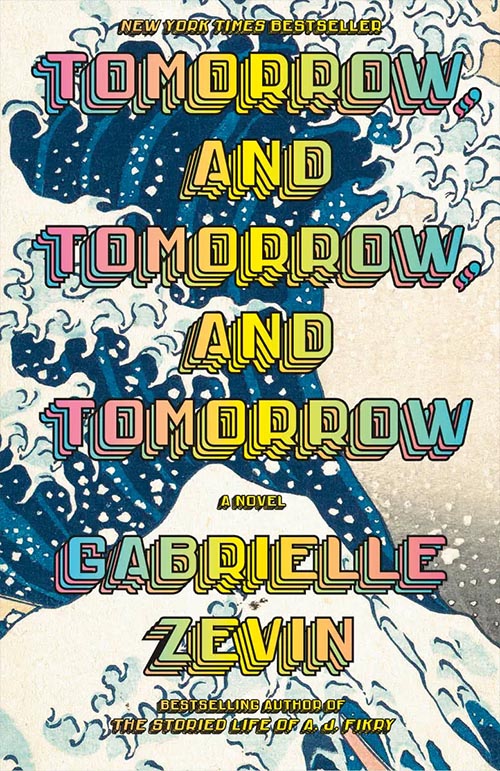
(Dreamstime/Darkworx)

I did not grow up playing video games. In fact, I used to associate video games with hyperfocused, headset-wearing young men who mutter angrily at a TV screen while playing "Call of Duty" or similar shooter games. But, it turns out, this imagination of video games as instruments of social isolation and violence is just a stereotype — not the whole story.
In Gabrielle Zevin's novel Tomorrow, and Tomorrow, and Tomorrow, video games are channels of healing, imagination and love. The book spans more than 30 years — from the 1980s to the 2010s — and follows the journey of two friends who create video games together.
Sadie Green first meets Sam Masur in a children's hospital in Los Angeles. Sam, a half-Korean boy who lives with his pizzeria-owning grandparents in K-Town, recently lost his mother and badly injured his left foot in a traumatic car accident; Sadie, a wealthy Jewish girl from Beverly Hills, spends days and nights at the hospital with her sister in the pediatric oncology wing. When the two children bond over playing video games in the hospital's game room, Sam had not spoken a single word in months.
A slow process of physical and emotional healing begins as the two children explore the world of video games and draw mazes for one another to solve.
Beyond their initial meeting in the hospital room, Sadie and Sam's friendship sees rifts, fractures and bickering. At times, the two are driven apart — for months or years — by arguments that stem from one or the other's blindness to disparities of wealth, disability, race or gender. Other times, the two meet again in tender moments of reconciliation and mutual care.
After not speaking for years, the two friends reconnect in 1997 while attending college in the same city. Sadie is a computer programming student at MIT who has developed her own games but now finds herself lost in a post-breakup depression. Upon learning about her depression, Sam trods to Sadie's apartment daily to visit her, despite the inconvenience to his own increasingly immobile left foot.
The effort is at first met with resistance and annoyance from Sadie, but the two gradually bond again over discussing Sadie's video game creations. Eventually, they create a game together: one with stunning graphics and haunting music about a little Japanese toddler, Ichigo, who is lost at sea after a shipwreck and must find his way back to the shore and to his family.
Over the span of several years, one successful game turns into two, then three, and soon after, a video game development company that Sadie, Sam and their friend Marx now chair.
In these video games, there is no shooting or killing, no monsters to fight. Instead the player finds vivid storylines that depict journeys of survival, resilience and imaginative hope.
In one, players become a girl with cancer who can switch between this universe — where she is bound to the hospital wing — and an alternate one where she has superpowers. The two worlds intertwine, with the outcome in one world dependent on the outcome in another, drawing players to a deeper reckoning of both the pains and transcendent hopes of people with chronic illnesses and disabilities.
Another, a world-building game, attends to the brokenness of the political world of the early 2000s. Released shortly after the tragedies of 9/11, the game-world creates a space of healing where an alternate world of peace and justice could be possible.
Building a world for another is a profound act of love, one of the book's characters remarks.
Following the brief legalization of gay marriage in San Francisco in 2004, which lasted several months before all 4,000 newly issued marriage licenses (including one of the book's supporting character's) were retracted, the video game world became a space where in-game marriage ceremonies could be performed between all people, no matter their gender.
But creating dream worlds and making video games with your best friend is not always a smooth venture: Throughout the next decade of working together, Sadie and Sam go through periods of creative differences and intense arguments.
Sadie and Marx fall in love, sending Sam into a spiral of emotions — perhaps jealousy, perhaps a feeling of loss. Sadie suffers a devastating loss and retreats away from the world of game creation, descending into grief that is only exacerbated by post-partum depression.
In one of the book's most moving chapters, the narrative arc abruptly cuts away from the present realities of Sadie's grief and Sam's desperate efforts to connect with her, and turns instead into the world within a game named "Pioneers," set in the Wild West. In this impeccably imagined chapter, the world of the "Pioneers" game and the world of the book's original characters slowly converge as the readers — and Sadie herself — gradually come to the realization that Sam has designed and built "Pioneers" to help Sadie heal from her trauma.
Advertisement
Building a world for another is a profound act of love, one of the book's characters remarks upon learning about "Pioneers." Tomorrow, and Tomorrow, and Tomorrow is in fact filled with such acts of deep, creative love between friends and between lovers.
At times, the imaginative worlds of video games are built as love letters from grieving game developers to the broken worlds they live in. For Sadie, Sam, Marx and their fellow game developers in the novel, the creative worlds of their video games serve not as an escape from the needs and reality of this world, but as a space where a different world can be imagined and reenacted.
In my study of eschatology and the Catholic imagination, I have read that eschatological hope — of a world and of a kindom that is different than our own — is what sustains us as people of faith living in worlds of violence, grief and injustice. Sometimes, however, our grief is too isolating; Our depressions keep us in bed; our traumas weigh us down. Sometimes, there is little energy to search for hope in this present world.
During those times, the worlds of our imaginations — through art, literature, media and yes, even video games — sustain us in our common search for healing, connection and eschatological hope.
Reinvigorated by these new hopes, we return to this world, and begin again.









